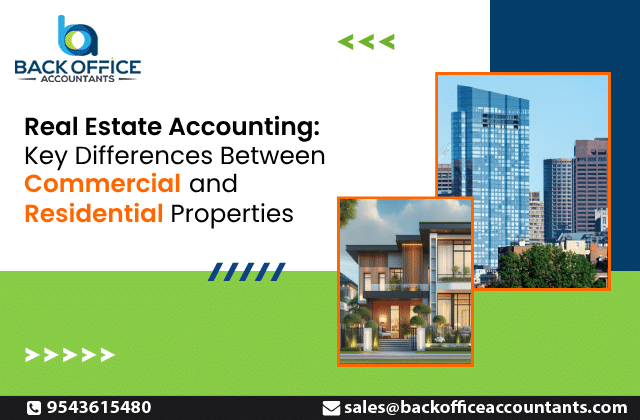Financial success in the field of real estate accounting depends on the ability to navigate the many differences between residential and commercial assets. Even though both industries manage real estate, there are substantial differences in their accounting in real estate procedures.
Complex lease agreements, tenant discussions, and property appraisals are frequently associated with commercial assets, including office buildings, retail stores, and warehouses. On the other hand, rental revenue, maintenance costs, and occupancy rates are usually the key concerns for residential properties, which include single-family houses, apartments, and condominiums.
Real estate professionals must comprehend these fundamental distinctions to handle money wisely, make wise judgments, and optimize profits. We will examine the different real estate accounting rules and procedures that apply to residential and commercial real estate in this investigation, providing insight into their respective financial environments.
Rental Income Sources
- Commercial Real Estate:
- Principal Source: Leasing space to businesses is the main source of rental income.
- Types of Leases: These are usually long-term agreements with business tenants.
- Lease Structure: Base rent, percentage rent, and triple net leases are examples of possible lease structures.
- Tenant Profile: Retailers, offices, and industrial tenants are among the businesses represented.
- Rent Determination: Rent is usually determined by factors including location, market demand, and square footage.
- Additional Income: Opportunities for additional revenue through common area maintenance fees, utility reimbursements, and lease escalations.
- Residential Real Estate:
- Principal Source: Rent received by renting out residential properties to individuals or families.
- Types of Leases: These are usually shorter-term contracts, such as annual or month-to-month ones.
- Lease Terms: Lease terms usually include a set monthly rent payment.
- Tenant Profile: People looking for homes, either alone or with their family.
- Determining Rent: Frequently impacted by elements including the size of the property, the facilities, and the state of the local rental market.
- Extra Income: There aren’t many options for making money outside from the regular rent payments; nonetheless, there can be costs associated with unpaid utilities.
Expense Allocation
The intricate structure of commercial assets requires careful attention when managing real estate assets and allocating expenses. Commercial buildings sometimes require more comprehensive care due to their greater rooms and specialized systems, which drives up maintenance expenditures relative to residential structures.
Furthermore, lease agreements usually determine how utilities are split up among tenants, particularly under triple net leases where renters pay for maintenance, insurance, and other property-related costs. Expenses for common spaces, such as parking lots, corridors, and lobbies are called Common Area Maintenance (CAM) and are usually split among tenants according to the amount of space they rent.
On the other hand, residential property expenditure distribution is often straightforward. Given the smaller scale of residential units, maintenance costs are usually lower than those for commercial properties. However, they nevertheless play a considerable role.
Generally speaking, the landlord is in charge of utilities, although depending on the terms of the lease, renters may occasionally be responsible for some utilities. Since renters usually do not share common spaces, Common Area Maintenance (CAM) charges are mostly not applicable in residential buildings.
Lease Negotiation Dynamics
The dynamics of lease negotiations vary greatly between residential and commercial buildings. Negotiations in business leasing frequently concentrate on longer-term agreements and more intricate lease arrangements. Tenants and landlords bargain over several items, such as triple net leases, percentage rent, and base rent, as well as the length of the lease and its possibilities for renewal.
In-depth talks on build-out allowances, operational concerns, and tenant upgrades may also come up during commercial lease negotiations. Landlords may also perform a thorough preliminary investigation on prospective commercial tenants to evaluate their viability as a business and their level of financial stability.
On the other hand, shorter terms and set monthly rent rates are usually the main points of contention in lease discussions for residential buildings. Negotiations are typically less complicated than commercial leases, even if they may still include some flexibility in the conditions of the lease, such as the duration or pet regulations. Prioritizing tenant screening and background checks can help residential landlords retain property value and ensure their rentals are suitable.
Want to smoothly enhance your real estate accounting procedures? Tailored solutions are offered by Back Office Accountants to help manage the intricacies of residential and commercial properties.
They ensure effective AP management in real estate for your real estate endeavors with our knowledge of cost allocation, the ins and outs of lease negotiations, and sources of rental revenue. Work with them to optimize your accounting procedures, make wise choices, and increase revenue in the dynamic real estate market.








